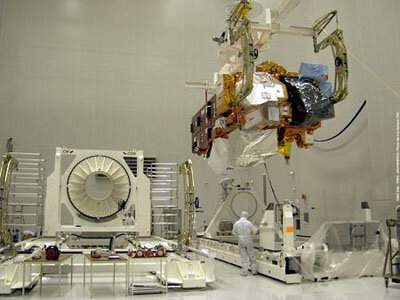Keeping one step ahead in French Guiana
ESA’s newest investment in Europe’s spaceport is the EPCU S5, a new state of the art satellite preparation complex built exclusively for Ariane 5. Financed by Arianespace and ESA, the EPCU S5 will make satellite preparation both easier and quicker.
The term EPCU comes from the French phrase for a satellite preparation building Ensemble de préparation des charges utiles; it is number S5 because this is the fifth satellite preparation complex to be built in Kourou.
The site is enormous, the buildings alone cover an area of almost 4 km2 while the site is 10 km2. It took two years to build and involved more than 50 companies. During the busiest periods, more than 400 people were working together on the complex.
This new satellite preparation building is made up of three 20-m high ‘clean’ rooms and huge 8 m wide and 12 m high corridors link the three rooms. Each room is able to contain several satellites at different stages of campaign preparation.
One of the most interesting innovations is the technology used to move the satellites from one building to another, which is based on that of the hovercraft. Satellites are placed on a pallet and then ‘float’ along the corridors on a pressurised cushion of air. In this way satellites can be moved from one room to another easily and smoothly.
Benefits

The new complex has many advantages over the old preparation buildings:
Firstly, it simplifies the work that has to be done during a satellite launch campaign as satellites can be prepared, moved and filled at the same time.
Secondly, up to four campaigns can be carried out at the same time in the same place.
Thirdly, as the complex has been built outside the danger zone and away from any falling debris, it is very safe. This means that work can continue even during launches.
Fourthly, the room used to fill the satellites with propellant has ducts around the outside. This increases safety and saves money, as any excess liquid propellant can be recuperated and automatically removed from the building to an area where it can be treated for reuse.
According to Fernando Doblas, Head of ESA’s office at Europe’s spaceport in Kourou, “this new complex means that each satellite takes less time to prepare, this will add more flexibility to the whole process and lead to savings in time and money”.
Envisat's arrival
Envisat, the EPCU S5’s first guest, arrived in May. This new ESA satellite is one of the largest and most complex Earth observation satellites ever to be built. On board the spacecraft will be 10 highly sophisticated instruments that will work day and night, in all atmospheric conditions, collecting crucial environmental data.
Envisat is now undergoing testing in the new complex prior to the beginning of the launch campaign. This will commence 8 weeks before it takes off for its journey into space aboard an Ariane-5 launcher on 28 February. Envisat, with its mass of 8 tonnes, will be the heaviest satellite ever to be put into orbit by an Ariane launcher.


